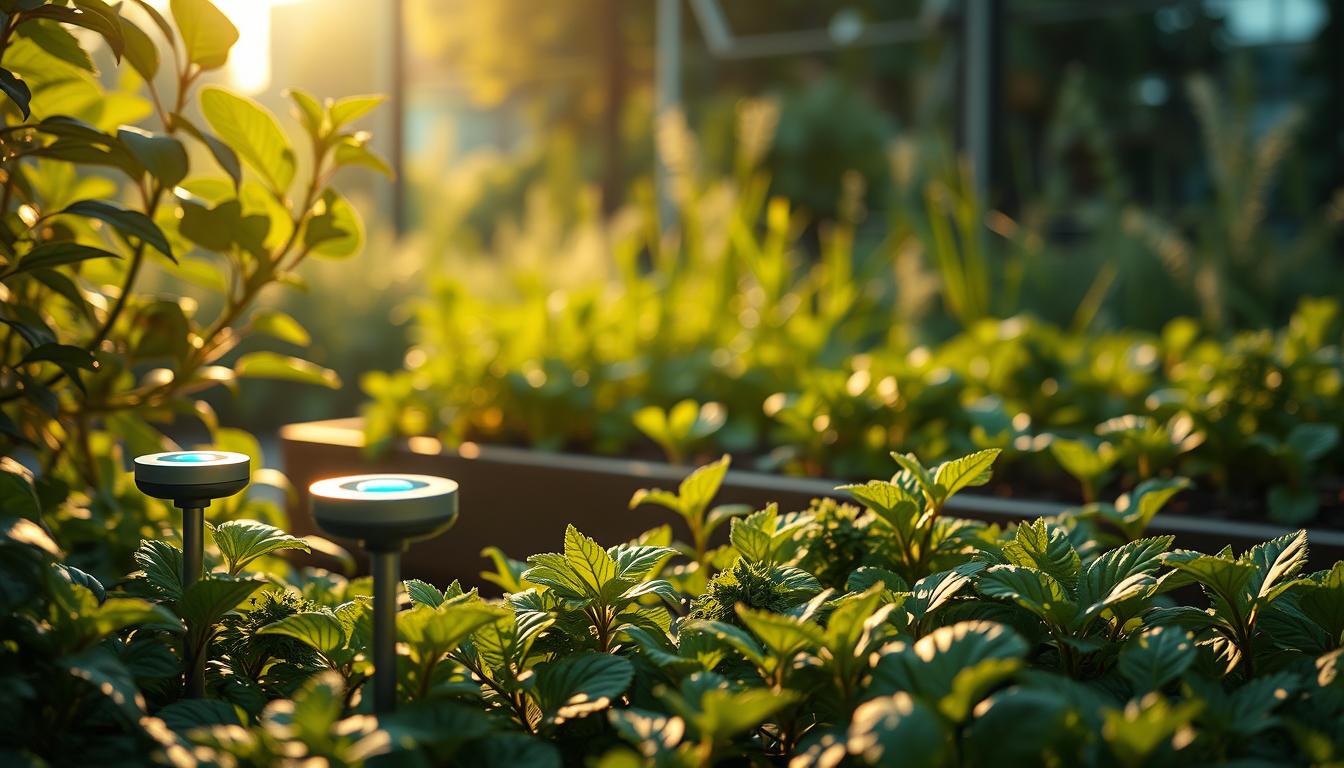Remember when we used to guess when to water or add fertilizer to our plants? Those days are disappearing fast. Digital technology is changing how we care for our gardens and indoor plants. Smart garden sensors are a big change for both new and seasoned plant lovers.
These devices connect technology with nature. They give us real-time info on soil moisture, sunlight, temperature, and nutrients. Now, we can make choices based on actual data from our gardens.
IoT garden monitoring systems link to your phone. They send alerts when your plants need water or more light. This tech doesn’t take away the fun of gardening. It makes it better by removing the uncertainty.
For those with busy lives, these digital tools help plants thrive even when we’re not around. They’re great for growing food, where the right conditions mean better crops. As we dive deeper, you’ll see how these tools can make gardening more enjoyable and less stressful.
The Evolution of Gardening in the Digital Age
Gardening has changed a lot, moving from old ways to using smart technology. For ages, people used their eyes and hands to grow plants. Now, digital tools are changing how we garden.
This change didn’t happen fast. Each new gardening tool built on old knowledge. It shows how we’ve gotten better at growing food and making our gardens pretty.
From Traditional Methods to Smart Technology
Long ago, people used simple tools like sticks and stones to garden. They learned from their families and watched nature closely.
The industrial era brought metal tools and early water systems. But gardeners still used their senses to know when to water or pick crops.
The digital age brought big changes. Now, we have sensors that check soil moisture better than our hands. Automated systems can spot changes we can’t see. These tools help gardeners understand their plants better.
Why Modern Gardens Need Digital Assistance
Today’s gardeners face new problems. Climate change messes with growing seasons and weather. Saving water is also key in many places.
City gardeners have small spaces and tough conditions. Busy people want to grow food and enjoy their gardens, but they don’t have much time.
Smart garden sensors help with these issues. They save water by watering just the right amount. Automated systems keep gardens healthy even when we’re not there.
Using technology doesn’t make gardening less personal. It makes it better. Digital tools help us focus on the fun parts of gardening.
Smart Garden Sensors: The Technology Behind the Revolution
Smart garden sensors use advanced technology to turn your garden into a digital system. They offer real-time insights that were hard to get before. This tech helps gardeners use these tools to their fullest potential.
These sensors don’t just read data; they process it and talk to other devices. This creates a smart garden management system. It’s part of the Internet of Things (IoT) garden monitoring world.
What Makes a Sensor “Smart”
Not all garden sensors are the same. A smart sensor can think for itself and send data wirelessly. It has a microprocessor that cleans up the data, making it more accurate.
Smart sensors learn and adapt over time. They use machine learning to understand your garden’s patterns. For example, they can tell if a moisture drop is normal or a sign of trouble.
Smart sensors can also act on their own. They can turn on irrigation when the soil gets too dry or adjust grow lights when it gets dark. This makes them more than just monitors; they’re garden managers.
Core Components and Communication Systems
Inside every smart garden sensor, there are many parts working together. The sensing elements collect data like moisture, temperature, and light. This data goes to a microcontroller that makes sense of it before sending it out.
These sensors need power to work, and they use low-energy designs. They often have solar panels or long-lasting batteries. They’re also weatherproof to protect the electronics from the elements.
Communication is key for these sensors to talk to control systems. They use wireless protocols to send data efficiently.
| Communication Protocol | Range | Power Usage | Best For |
|---|---|---|---|
| Bluetooth | 30-50 feet | Low | Small gardens with nearby control hub |
| Wi-Fi | 100-300 feet | Medium-High | Gardens with existing home networks |
| Zigbee/Z-Wave | 35-300 feet | Very Low | Complex sensor networks with multiple devices |
| LoRa | Up to 6 miles | Very Low | Large properties or farms with distant sensors |
Types of Environmental Data Sensors for Home Gardens
Environmental data sensors have changed home gardening. They give precise measurements of important growing parameters. These smart devices help your plants by turning their needs into data you can use.
Now, gardeners have many sensors to monitor their gardens. These sensors track every part of the garden’s environment. This lets you create the best growing conditions for your plants.
Choosing the right sensors is key. They work together to show your garden’s health. This helps you solve specific gardening problems and meet your plants’ needs.
Soil Moisture and Nutrient Monitors
Soil moisture sensors are essential for any smart garden. They check the water in your soil. This helps you keep the right moisture for your plants.
Nutrient monitors go further by checking important elements like nitrogen and potassium. They also measure soil pH and salinity. It’s important to place sensors correctly to get accurate readings.
These monitors prevent plants from getting too dry or too wet. You can set alerts when the soil is not right for your plants.
Temperature and Humidity Trackers
Temperature and humidity trackers watch the air conditions that affect plants. They detect air temperature changes that can harm plants.
Humidity sensors check the air’s moisture. This affects how plants lose water and their disease risk. Plants need the right humidity to stay healthy.
Modern trackers also calculate dew point and vapor pressure deficit. This helps gardeners manage greenhouses and protect plants during changes in weather. They can even predict disease risks based on humidity.
Light Exposure and UV Measurement Tools
Light sensors measure sunlight’s intensity, duration, and quality. They help you place plants in the right light. This is important for plants that need sun or shade.
Advanced light sensors can tell the difference in light types. They measure PAR, which plants use for growth. They also track UV exposure, which affects plant health.
Indoor gardeners and greenhouse owners find these sensors very useful. They help decide when to add extra light. Many systems work with smart lighting to ensure plants get the right light all year.
How IoT Garden Monitoring Creates Smarter Gardens
IoT garden monitoring combines technology and nature, making gardens more sustainable and productive. It turns ordinary gardens into smart ecosystems that adapt to changes without needing humans. This network of devices collects and shares data to improve plant growth in ways we couldn’t imagine before.
IoT garden monitoring creates a digital system in your garden. Smart sensors gather data on plants’ needs and environment. This data goes to a central hub or your phone, helping you make better gardening choices.
Real-Time Data Collection and Analysis
IoT garden monitoring offers real-time insights, unlike manual checks. Smart sensors detect changes in soil moisture, temperature, and light as they happen. This means you can act quickly, not hours or days later.
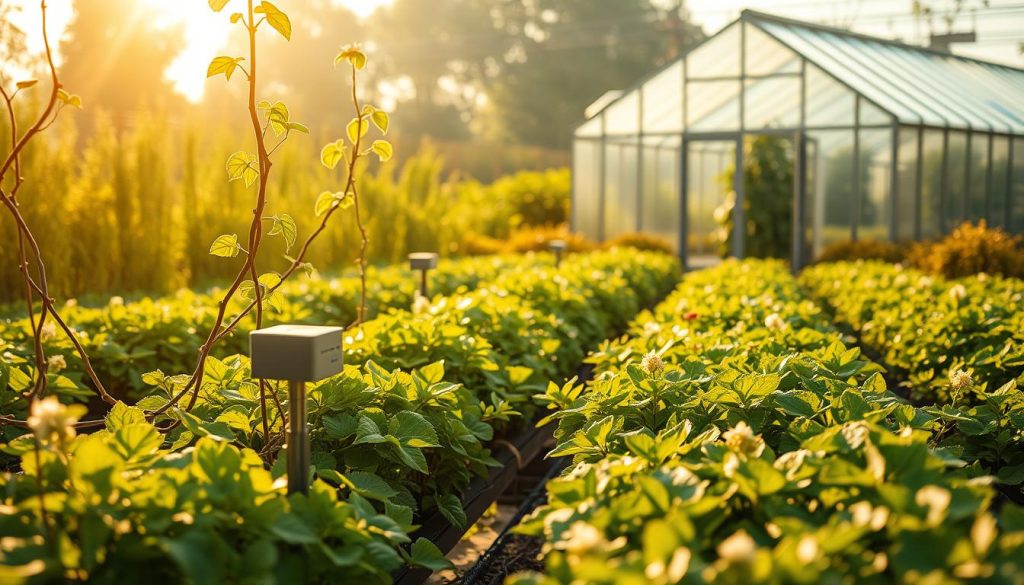
IoT systems analyze this data to find patterns we can’t see. For example, they can predict frost risk by linking temperature drops to moisture levels. They also track how plants respond to different care routines over time.
This data leads to practical advice. IoT systems suggest watering schedules based on soil conditions, not just dates. Some systems even show your garden’s health through color-coded maps or graphs, making data easy to understand.
Wireless Connectivity Options for Garden Networks
The success of IoT garden monitoring depends on its connectivity. Different wireless technologies suit different garden sizes and needs.
Wi-Fi is great for high data transfer rates, but needs to be close to your router and uses more power. Bluetooth is good for small gardens, easy to set up, and uses little power, but has a short range.
Zigbee and Z-Wave are best for large gardens. They create mesh networks that extend coverage. These technologies are low power, so sensors can last a long time on one battery.
Cellular-connected sensors are perfect for remote gardens without Wi-Fi. They use mobile networks to send data, working anywhere with cell coverage, but cost more.
Choosing the right connectivity for your garden ensures your plants get the care they need. A well-connected IoT garden monitoring system turns occasional care into a data-driven approach. This helps plants grow well with less waste and more results.
Smart Irrigation Controllers: Transforming Water Management
Smart irrigation controllers are changing how we use water in gardens. They go beyond simple timers to adjust watering based on garden conditions. These devices use data and algorithms to save water and help plants thrive.
Old irrigation methods waste up to 50% of water. Smart controllers fix this by making smart watering decisions.
Precision Watering Based on Real Needs
These controllers give plants just the right amount of water. They use soil sensors, weather forecasts, and more to create perfect watering plans.
Unlike old timers, these systems tailor watering to your garden’s needs. They use deep watering, pulse irrigation, and more to help plants grow strong.
- Deep watering cycles that encourage stronger root development
- Pulse irrigation that allows water to penetrate compacted soil gradually
- Zone-specific schedules that account for different plant types, sun exposure, and soil conditions
- Time-of-day optimization that reduces evaporation by watering during cooler hours
They also manage different watering methods like drip systems and sprinklers. This ensures each plant gets water efficiently.
Drought Response and Conservation Benefits
Smart irrigation controllers are great during water shortages. They adjust to droughts without harming plants.
Using these systems can cut outdoor water use by 20-50%. This means big savings for households, both in water and money.
During droughts, these systems:
- Automatically reduce watering while keeping plants healthy
- Focus on essential plants over decorative ones
- Don’t water when rain is coming
- Slowly cut water use to help plants adjust
These controllers also save gardeners time and stress. No need to rush home to turn off sprinklers or worry about watering during hot spells. The system takes care of it all.
As water becomes more valuable, smart irrigation controllers are key for eco-friendly gardeners. They’re not just convenient but also a duty to protect our water.
Beyond Basic Readings: Advanced Soil Analysis Systems
Soil sensors have grown beyond just checking moisture levels. They now offer detailed insights, similar to lab tests, right in your garden. These advanced systems change how we see our soil’s complex world. They give us data on many soil aspects at once, helping us make better gardening choices.
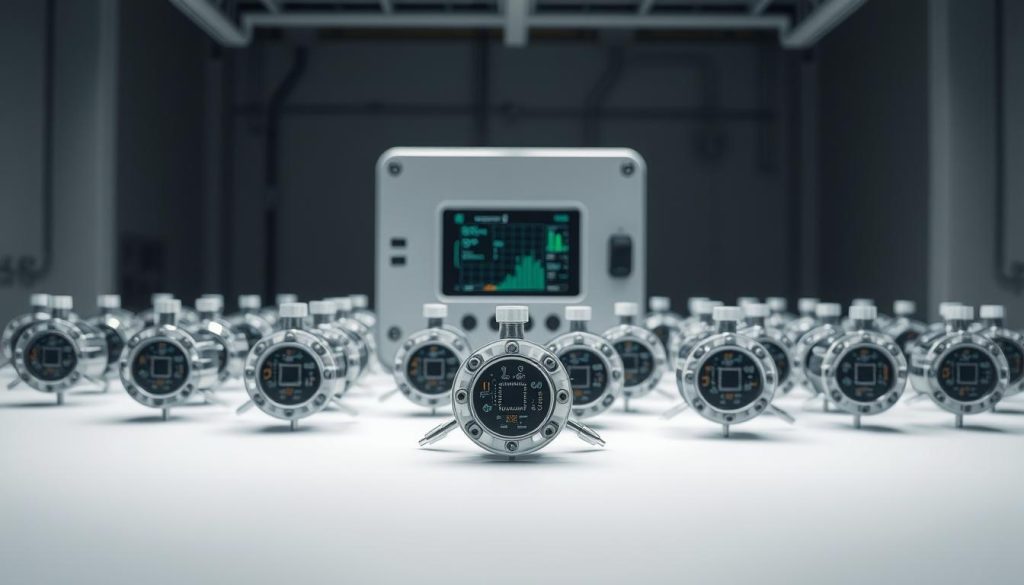
Comprehensive Soil Health Monitoring
Today’s soil monitoring systems check many important factors for plant growth. They track pH levels and electrical conductivity. These help us understand nutrient availability and salt levels in the soil.
Top-notch soil moisture sensors also find nutrients like nitrogen and potassium. This means no more waiting for lab results. You get instant updates on your soil’s nutrient levels.
Some systems even look at organic matter and microbial life. This lets gardeners see how soil biology works. It helps us create the perfect growing space for our plants.
Data-Driven Soil Amendment Strategies
Advanced soil sensors change how we use soil amendments. Instead of using the same fertilizers for everyone, we tailor them to our soil’s needs. This means applying exactly what our soil requires, at the right time.
If sensors show a nutrient shortage, we can fix it with specific fertilizers. For example, if nitrogen is low but phosphorus is fine, we use a nitrogen-rich fertilizer. This way, we avoid wasting resources and protect our soil and environment.
Using data to manage our soil leads to healthier soil over time. It improves structure, water retention, and nutrient cycling. This results in stronger plants that need fewer inputs.
Plant Health Sensors: The Early Warning System
Imagine having a digital guard that watches over your plants day and night. It alerts you to diseases and pests before they cause harm. This is what plant health sensors do for gardens today. They catch tiny changes in plants that we can’t see until it’s too late.
Smart garden sensors are more than just weather trackers. They use advanced tech to spot stress, disease, and pests early. This gives gardeners a chance to act fast and prevent bigger problems.
Disease Detection Before Visual Symptoms Appear
Plant health sensors can find diseases days or weeks before we see them. They look for small changes in temperature, chemicals, and electrical signals in plants.
Many diseases make plants react before we see any signs. These sensors catch these early signs. This means gardeners can treat problems before they get worse.
Case Studies in Disease Prevention
In Seattle, a community garden used sensors to catch powdery mildew in squash early. They treated it before it spread, saving their plants.
In California, a vineyard used sensors to find grapevine downy mildew early. They saved 40% of their crop by acting fast.
Interpretation of Plant Stress Signals
Understanding what sensors say takes some knowledge. Modern sensors help by showing different types of stress:
- Disease stress: Shows in leaf temperature and VOCs
- Nutrient deficiency: Seen in electrical conductivity and growth patterns
- Environmental stress: Detected in transpiration rates and stem changes
- Pest damage: Identified by vibration and stress hormones
Automated Pest Monitoring and Alerts
Smart garden sensors are great at finding pests early. They use cameras and AI to spot insects and count them. This alerts gardeners to act before pests harm plants.
Digital pheromone traps attract pests and count them. They track pests over time and alert gardeners to act fast.
Vibration sensors on plants detect pests like root weevils. This tech finds pests that hide in soil, helping gardeners catch problems early.
The best part of automated pest monitoring is its accuracy. Gardeners can use less pesticide and keep plants healthier by treating only when needed.
Connected Garden Solutions: Integration with Smart Homes
The modern smart garden is now a part of your smart home. It’s no longer just a separate tech space. With gardening tech getting better, the lines between inside and outside smart systems are fading. This creates a chance for fully connected living spaces.
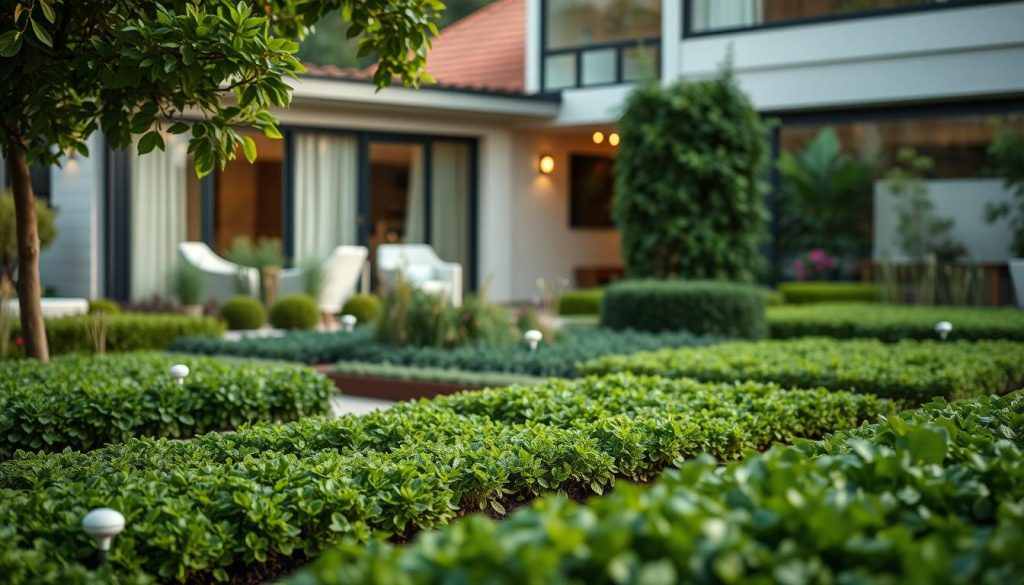
These systems are a big step up from just garden sensors. When your garden joins your smart home network, you get full control and insights. This changes how you garden and manage your home.
The real strength of automated gardening systems is when they work with other smart devices. This is a big improvement over just using garden sensors alone.
Creating a Unified Garden-Home Ecosystem
A unified garden-home ecosystem links your outdoor and indoor spaces. It uses shared data and actions. For example, your irrigation system can talk to your smart water meter to save water.
Garden lights can work with your home security system. They light up paths when you come home at night. Some systems even suggest recipes based on what’s ready to pick in your garden.
Weather stations and garden sensors are a powerful combo. They can prepare your garden for storms by closing vents or adjusting watering. This keeps your garden safe and saves water.
Voice Commands and Mobile Control Options
Managing your garden with voice commands is super easy. You can use Amazon Alexa, Google Assistant, or Apple Siri to control your garden. Just say what you want, like checking soil moisture or starting irrigation.
Mobile apps are the main control center for automated gardening systems. They let you monitor and control your garden from anywhere. You can see real-time data, get alerts, and change settings from your phone. Many gardeners like checking on their plants while they’re away.
Remote monitoring makes gardening easier for busy people or those with limited mobility. You can keep an eye on your garden without being there. This tech makes gardening accessible to more people, no matter their schedule or experience.
The Economics of Sensor-Based Plant Care
Buying garden sensor technology means weighing initial costs against long-term savings. The first price might seem high, but many gardeners see savings in efficiency and less waste. Knowing this balance helps gardeners choose the right tech for their needs.
Initial Investment vs. Long-Term Resource Savings
Basic smart garden sensors cost $30-$100, while full systems with many sensors and controls are $200-$500. Top-of-the-line systems with advanced features can be over $1,000.
These investments can save a lot over time. Smart irrigation systems cut water use by 20-50%, saving hundreds on water bills. Also, precise nutrient monitoring can reduce fertilizer waste by up to 30%.
Quality sensors last 3-5 years. Many systems are modular, making it easy to replace parts without buying a whole new system. Gardeners save 2-3 hours a week by not monitoring manually.
Environmental and Personal Value Proposition
Using sensor-based plant care also has big environmental benefits. It saves water and cuts down on chemical runoff. This is good for our planet.
For gardeners, the benefits go beyond money. They can see a 15-30% increase in harvests. This means more food and less waste. It also means fewer plants die from bad watering or nutrients.
Many gardeners feel less stressed when sensors do the work. They can enjoy gardening more. The feeling of using green tech is a big plus for those who care about the environment.
Precision Agriculture Techniques for Home Gardeners
Home gardeners are now enjoying a tech revolution. What used to need big farms and expensive tools can now fit in a small space. This change makes advanced gardening easy for anyone to try.
Precision agriculture uses sensors to help plants grow better and use less. For gardeners, this means making smarter choices based on real data, not just guesses.
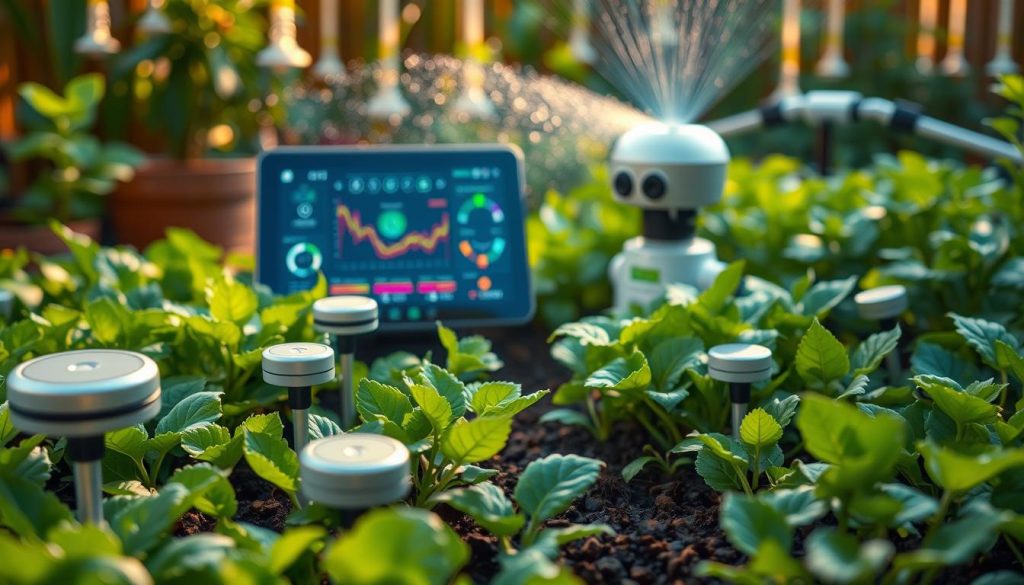
Commercial Farming Technologies Scaled for Backyards
Big farm tech is now available for home gardens. These smaller versions work well and are easier to use and buy.
Systems that used to be on big tractors are now in smart sprinklers and fertilizers. They adjust based on soil readings. Microclimate mapping helps gardeners understand their garden’s unique conditions.
- Growth tracking analytics that monitor plant development in real-time
- Predictive harvest tools that estimate optimal picking times
- Automated irrigation systems that respond to weather forecasts
- Soil analysis platforms that provide amendment recommendations
Maximizing Yield in Limited Spaces
Precision techniques are perfect for small gardens. Sensors help gardeners decide where to plant and how to care for their plants.
Vertical gardens get better care with precision monitoring. Succession planting is more reliable with sensors tracking soil conditions.
Companion planting gets smarter with microclimate data. Gardeners can grow more plants closer together, thanks to careful monitoring of moisture and nutrients.
Even small gardens can produce a lot with precision techniques. This approach saves resources and makes gardening easier.
Overcoming Challenges in Automated Gardening Systems
The path to fully automated gardening is not easy. Technical limits and adoption barriers shape the digital garden management world. Smart sensors and precision agriculture have great potential, but knowing their limits is key. This way, gardeners can work around problems and enjoy their systems more.
Technical Limitations and Reliability Issues
Even top-notch automated gardening systems face technical hurdles. Sensor accuracy is a big worry, as readings can change over time or be off during bad weather. This can mess up watering schedules or soil checks.
Battery life is another big challenge, mainly for wireless sensors in the garden. These systems often need batteries replaced or recharged often, which can be forgotten. Also, signal problems, range limits, or network outages can stop your garden’s digital system.
Outdoor electronics face risks from moisture, UV damage, and extreme temperatures. These can shorten device life or cause odd behavior. Software bugs and compatibility issues can also lead to system failures.
| Common Technical Issue | Impact on Garden | Troubleshooting Solution | Preventive Measure |
|---|---|---|---|
| Sensor Calibration Drift | Inaccurate moisture readings leading to over/under watering | Manual recalibration against known reference | Quarterly calibration checks during season changes |
| Battery Failure | System shutdown and data loss | Implement backup power source | Calendar reminders for battery replacement |
| Connectivity Interruptions | Missed alerts and watering cycles | Install signal boosters or mesh network | Configure offline backup modes |
| Weather Damage | Physical component failure | Use protective casings and covers | Strategic placement in semi-protected areas |
Bridging the Digital Divide in Gardening
The digital divide in gardening is a big issue. Many gardeners are hesitant about technology or doubt its value. This gap exists between tech lovers and traditional gardeners who could really benefit from new tools.
Cost is another barrier, as good systems can be expensive. While they save resources in the long run, the initial cost is a hurdle. The learning curve for setting up and using these systems also keeps some people away.
To bridge this gap, tech needs to be easier to use and understand. Makers are making systems simpler and more intuitive. Community programs and extension services are offering workshops on smart gardening, helping people learn.
Hybrid systems that mix digital tools with traditional gardening are a good compromise. They use technology to help, not replace, the gardener’s knowledge. This way, gardeners can use digital tools to enhance their gardening, not just do it all for them.
Embracing the Garden of Tomorrow: Human Touch in a Digital Landscape
Smart garden sensors are changing how we garden, but they’re not replacing the joy of gardening. They help us notice things we might miss. This lets us focus on the fun parts of gardening.
These sensors give us insights into our gardens. They alert us to problems like too much water or not enough nutrients. This way, we understand our plants better, not just care for them.
Connected garden solutions are best when they help us, not replace us. Gardeners who use technology wisely have more time for important tasks. They can pick new plants, design gardens, and enjoy the beauty of their work.
In the future, garden sensors will help us grow food better and create strong green spaces. They will support biodiversity and adapt to climate change. This will make gardening more sustainable and green spaces more resilient.
The garden of tomorrow will mix digital tools with nature’s beauty. Technology will help us care for plants, but the core of gardening stays the same. It’s about nurturing life and finding peace with nature.

